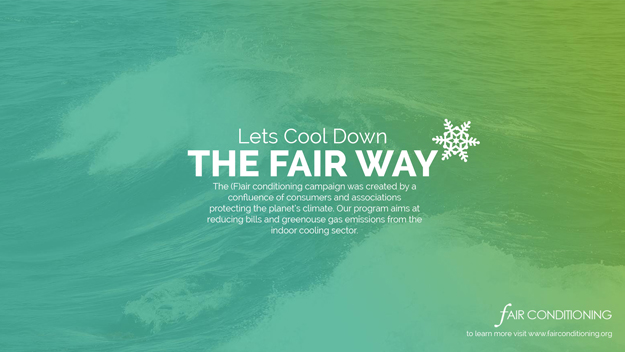A cool roof reflects most of the incident sunlight and emits some of the absorbed radiation back into the atmosphere, instead of passing the heat on to the building below. As a result the roof stays cooler – maintains a lower surface temperature – keeping the building below at a cooler and more constant temperature. Cool roofs are known to stay 10 to 16 celsius cooler than a normal roof under a hot summer sun. This greatly reduces heat gain inside the building and the cooling load that needs to be met by the HVAC system. The term, ‘cool roof’ refers to the outer layer or exterior surface of the roof which acts as the key reflective surface. These roofs have a higher solar reflectance than a typical roof surface. The term ‘cool roof’ encompasses an extensive array of roof types, colors, textures, paints, coatings, and slope applications. (Cool roofs for cool Delhi: Design Manual – BEE)
Cool Roof vs Conventional Roof

Reflectance, Absorptance, and Emissivity
The two primary thermal properties that characterize roofs are solar reflectance and thermal emittance. Surfaces with low solar reflectance, absorb a high fraction of the incoming solar energy. A fraction of this absorbed energy is conducted into ground and buildings, a fraction is convected to the ambient air, and a fraction (termed emissivity) is radiated back to the sky. For equivalent conditions, the lower the emissivity of a surface, the higher will be its steady-state temperature. Surfaces with low emissivity cannot effectively radiate to the sky and, therefore, get hot. (Cool roofs for cool Delhi: Design Manual – BEE).
Cool Roof Heat Transfer
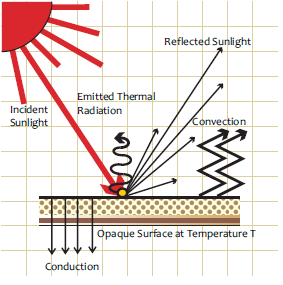
Thermal Emittance or Emissivity
Thermal Emittance or Emissivity of a material is the ratio of energy radiated by a particular material to energy radiated by a black body at the same temperature. It is a measure of a material’s ability to radiate the absorbed energy. A true black body would have an e = 1 while any real object would have e <1. Emissivity is a dimensionless quantity (does not have units). In general, the duller and blacker a material is, the closer it’s emissivity is to 1. The more reflective a material is, the lower its emissivity. The emissivity of building material, unlike reflectance, is usually measured in the far infrared part of the spectrum. (ECBC Envelope for Warm & Humid Climate)
Solar Reflectance and Absorptance
Solar reflectance is the fraction of solar radiation reflected by a roof. The complement of reflectance is absorptance; whatever radiant energy incident on a surface that is not reflected is absorbed in the roof. The reflectance and absorptance of building materials are usually measured across the solar spectrum, since these are exposed to that range of wavelength. Reflectance is measured on a scale of 0 to 1, with 0 being a perfect absorber and 1 being a perfect reflector. Absorptance is also rated from 0 to 1, and can be calculated from the relation: Reflectance + Absorptance = 1. (ECBC Envelope for Warm & Humid Climate)
Solar Reflectance Index (SRI)
The Solar Reflectance Index (SRI) is a measure of the solar reflectance and emissivity of materials that can be used as an indicator of how hot they are likely to become when solar radiation is incident on their surface. The lower the SRI, the hotter a material is likely to become in the sunshine. (www.designingbuildings.co.uk)
Cool roofs can be selected from a wide variety of materials and colors, and can be advantageously applied to almost any building or roof type, and in most locations. Conventional materials for standard roofing are now available with their cool roof counterparts. The table below lists the SRI for common roofing materials. White roofs are characterized by a high SRI. (Cool roofs for cool Delhi: Design Manual – BEE).
SRI Values for Generic Roof Materials
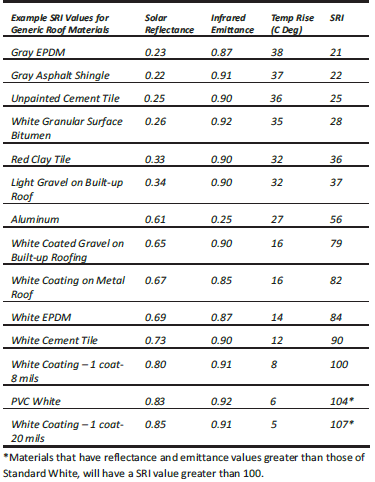
Climate is an important consideration when deciding a cool roof installation. Cool roofs achieve the greatest cooling savings in hot climates, but can increase energy costs in colder climates due to reduced beneficial wintertime heat gains. Roof coatings should include special chemicals that prevent mold or algae growth for a few years. In warm, moist locations, cool roof surfaces can be more susceptible to algae or mold growth than hot roofs. Proper design techniques should be used to avoid condensation, especially in cold climates. In cold climates, roofs can accumulate moisture through condensation, and it is possible that cool roofs might be more susceptible to accumulating moisture than dark roofs of the same design. Decision on cool roofs should be taken by keeping in mind both installation costs (material and labour) and ongoing maintenance costs (repair, recoating, and cleaning). In most cases, however, they are considered an inexpensive energy efficiency measure in buildings. (www.nzeb.in)
- Recommendations on cool roof materials includes use of well-graded broken pieces of glossy glazed tiles (broken china mosaic), modified bitumen with plastic and a layer of reinforced material, RCC roof topped with elastomeric cool roof coating, or simply finished with broken white glazed tiles. (www.nzeb.in)
Modified Bitumen With Cool Roof Coating

- Specialized white elastomeric coatings are available for low-sloped products and cool color polymer coatings are available for tiles – these can be sprayed on existing roofs. The white pigment in coatings is typically titanium dioxide. Once applied, the coating is what determines the reflective properties of the roofing product. (Cool roofs for cool Delhi: Design Manual – BEE).
White Elastomeric Coating
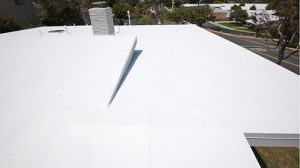
- Slate and tile products are available with solar-reflective surfaces that offer a wide range of cool colors. Additionally, the dense, earthen composition of slate and tile products provides increased thermal mass, yielding additional energy savings not realized through solar reflectance and thermal emittance measures alone. Concrete and clay tiles may be obtained in white, increasing the solar reflectance to about 70 percent (compared to the 20-30 percent range for red tile). (Cool roofs for cool Delhi: Design Manual – BEE)
Concrete Tiles
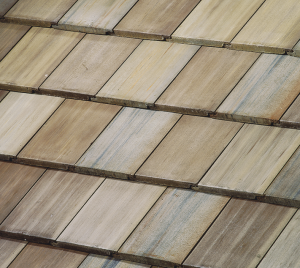
- Broken China Mosaic Terracing. Well-graded broken pieces of glossy glazed tiles provide an inexpensive and conducive cool roofing option. Broken pieces of glazed tiles (preferably white) are embedded in wet mortar to provide a smooth surface that does not undulate. The joints are then grouted using cement mortar with waterproofing material. (Cool roofs for cool Delhi: Design Manual – BEE)
Broken China Mosaic
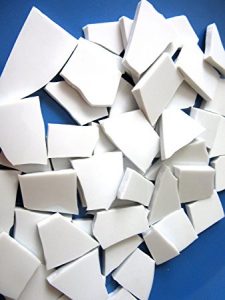
- The metal roof systems are available in white, which raises their solar reflectance to about 65 percent. Unpainted metal should be covered with a white coating to increase its emittance. (Cool roofs for cool Delhi: Design Manual – BEE)
- The roof surface should be a light color with the following characteristics: Solar Reflectance (SR) of > 0.7; Thermal Emittance (TE) of > 0.75; and Solar Reflectance Index (SRI) of 50% or more. (www.2030palette.org)
All roofs that are not covered by solar photovoltaics, or solar hot water, or any other renewable energy system, or utilities and services that render it unsuitable for the purpose, shall be either cool roofs or vegetated roofs. For qualifying as a cool roof, roofs with slopes less than 20° shall have an initial solar reflectance of no less than 0.60 and an initial emittance no less than 0.90. Solar reflectance shall be determined in accordance with ASTM E903-96 and emittance shall be determined in accordance with ASTM E408-71 (RA 1996).
Cool roofs are very effective in reducing the summer electricity use with minimal impact on winter heating. In general, savings in annual net utility costs can be expected for most buildings. Research has shown that cool roofs also help increase the life expectancy of roofing systems because extreme cycles of heating and cooling tend to wear out materials as they expand and contract with the temperature. Cool roofs on the other hand, keep the roof a more constant temperature and therefore, tend to last longer. While reducing ambient air temperatures, cool roofs also improve air quality by curtailing or eliminating smog formation. Smog is created by photochemical reactions of air pollutants – higher temperatures provide impetus to these reactions. Improved air quality also results in a reduction in heat-related and smog-related health issues, including heat stroke and asthma. (Cool roofs for cool Delhi: Design Manual – BEE)
Studies show that in warm and hot climates cool roofs perform well in meeting energy efficiency, cost-effectiveness, and sustainability. Cool Roofs reduce annual air conditioning energy use of a single-story building by up to 15%. They cool interior spaces in buildings that do not have air conditioning, making occupants more comfortable. Cool Roofs reduce carbon emissions by lowering the need for fossil-fuel generated electricity to run air conditioners and they potentially slow global warming by cooling the atmosphere. (www.nzeb.in)
Results of the study “Calibrated simulation for estimating energy savings by the use of cool roof in five Indian climatic zones” show that the maximum reduction in energy consumption is observed in Mumbai (warm and humid climate), followed by Ahmedabad (hot and dry climate), Bangalore (temperate climate), and Delhi (composite climate). Least energy saving is observed in Shillong (cold climate). In all the climates except cold, the financial payback period is acceptable, being less than three years, whereas for cold climate, the payback period is over six years. (www.coolrooftoolkit.org).
Office Buildings in Hyderabad
The complex houses two near-identical buildings – this facilitated the study through ensuring identical parametric values for floor area, number of floors, roofing material and system, occupancy and schedules, and cooling systems. These two buildings are is a two-stories with a roof area of 700m. The roof of one building was painted black, and the roof of the other was painted with a white reflective cool roof coating. Weather towers, temperature sensors, current transducers, and data-loggers continuously monitored the weather, energy-use, and temperature data for the two buildings. The data points monitored weather conditions (outdoor temperature, relative humidity), building temperatures (surface temperature, heat flux through the roof, roof underside temperature, indoor air temperature), and energy use (whole building electricity use, cooling energy use). The average summertime daily roof surface temperature was reduced by 20 degrees celsius. Cooling energy savings due to cool roofing (from gray concrete to white roof coating) can vary largely, for example, ranging from approximately 15% to 20% during hot summer days. (Cool roofs for cool Delhi: Design Manual – BEE)
Comparison of Surface and Under-surface Temperatures Before and After Application of Cool Roof Coating
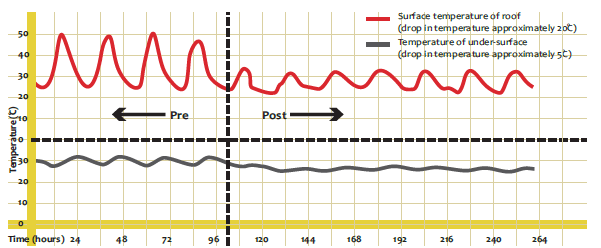
Publications
Al-Obaidi, K.M., et al., Passive cooling techniques through reflective and radiative roofs in tropical houses in Southeast Asia: A literature review. Frontiers of Architectural Research 2014, http://dx.doi.org/10.1016/j.foar.2014.06.002
BEE, “Cool roofs for cool Delhi”: Design Manual, 2011. http://shaktifoundation.in/wp-content/uploads/2014/02/cool-roofs%20manual.pdf
ECBC Envelope for Warm & Humid Climate http://high-performancebuildings.org/pdf/ECM2/ECM2_Technical_Information_Warm-Humid.pdf
Levinson R, Akbari H. 2010. Potential benefits of cool roofs on commercial buildings: conserving energy, saving money, and reducing emission of greenhouse gases and air pollutants. Energy Efficiency. 3:53-109
Online Resources
Tools
Indian Cool Roof Calculator: http://coolroof.cbs.iiit.ac.in
US Cool Roof Calculator: http://web.ornl.gov/sci/buildings/tools/cool-roof
Simple White Paint-Exterior Grade
| Manufacturer | Product | Contact |
| Asian Paints | Apex Ultima (white colour) | Asian Paints Limited 6A, Shantinagar, Santacruz (E), Mumbai - 400 055. India. Tel: 022 - 3981 8000 Fax: 022 - 3981 8888 |
| Pidilite | Dr. Fixit Heatshield | Pidilite Industries Limited, Ramkrishna Mandir Road, P.O. Box No.17411, Andheri East, Mumbai, 400059, Tel: 022 2835 7000, Fax: 022 2835 7008, E-mail: drfixit@pidilite.com |
| Dulux | Dulux Weathershield | |
| Nerolac | Excel Tile Guard | Ganpatrao Kadam Marg, Lower Parel, Mumbai 400 013, Tel: 022 2493 4001/2499 2500, Fax: 022 2491 9439 |
| Berger | WeatherCoat AllGuard/Longlife (white colour) | 129 Park Street, Kolkata 700017, Mobile: 0091 33 2229 9724, Fax: 0091 33 2249 9009/9729 |
| British Paints | No.19, D.D.A. Commercial Complex, Kailash Colony Extension, New Delhi, Delhi 110 048, Tel: 0091 11 2924 0394/2924 0395, Mobile: 0091 9350 63 2236, Fax: 0091 11 2923 3390 | |
| Shalimar | Shaktiman Exterior Acrylic Emulsion | Shalimar Paints Limited, 5th Floor, C Wing, Oberoi Garden Estate , Chandivili Farm Road, Chandivili, Andheri East, Mumbai 400 072, Tel: 022 2857 4043/6147, Fax: 022 2857 3725 |
| Oikos | Betoncryll Pigmentato | Oikos India Pvt. Ltd., 29, Block 3, Tribhuvan Complex, Ishwar nagar, Mathura Road, New Delhi 110 065, Mobile: 0091 98 107 73731, Tel: 0091 11 4260 3212, Fax: 0091 11 4260 3212 |
Reflective Roof Coatings
| Manufacturer | Product | Contact |
| Thermoshield India Pvt Ltd | High Albedo Roof Coating | Tel: 0091 80 2320 79570 Fax: 0091 80 2320 7958, Email : sales@thermoshieldindia.com, Website: www.thermoshieldindia.com |
| TRUWORTH Impex Pvt Ltd | Solargard Roof Coating | 22, Sant Bhavan, Above State Bank of Hyderabad, Marve Road, Malad West, Mumbai 400 064, Tel: 022 3251 0059, Direct 1 Telefax: 022 2844 0992 |
| Dolphin Floats Pvt Ltd India | Modified Acrylis waterproofing coatings (Seal-n-Cool) | Mr. Alok Telang/ Mr. Adish, EL-25/5, First And Second Floor, MIDC, Bhosari, Pune, Maharashtra 411 026, Website: www.dolphinfloats.co.in, Tel: 0091 20 2712 1859, Mobile: 0091 9373 9897 67 |
| JOTUN Paints | Jotashield Thermo | 204 & 205, Ascot Centre, Sahar Road, Andheri East, Mumbai 400 099, Tel: 0091 22 2822 4600, 0091 22 2820 5900, Fax: 0091 22 2820 5900 |
| Unnathi Group | Cool Coat | 3, 1st Cross, Netaji Circle, Mathikerer Ext., Bangalore 560 064, Email: unnathigroups@gmail.com, Tel: 080 2360 4570 Mobile: 0091 99 8600 4163, 0091 98 4555 4959 |
| D&D Roof Insulations | Durafoil | Naveen Sangari, 098 9907 4143 |
| Henkel | Polytex | Greentech Engineers, 18, Kariyammana Agrahara Belandur Post, Bangalore 37, Tel: 0091 80 6530 8162/6568 8685, Fax: 0091 80 4126 2824, Mobile: 09845190272,09886552322 |
| Thermatek | Heat Resistant Terrace Tiles | ISHAAN INDUSTRIES, An Associate of Parashuram Poterry Works Co. Ltd. Gandevi Road, Bilimora 396 380, Dist. Nasvari, Gujarat, Tel: 02634 284416, Mobile: 9426117277, Email: admin@thermatek.co.in |
Tiles/Mosaic
| Manufacturer | Product | Contact |
| Kajaria | Stonelo Blanco (Floor Tiles 300×300) | J1/B1 (Extn.), Mohan Co - op, Industrial Estate, Mathura Road, Badarpur, New Delhi - 110044, Tel: 011 2694 6409 Fax: 011 2694 6407/2694 9544, Email : newdelhi@kajariaceramics.com |
| Bell | Mont Blanc (Floor Tiles 300×300) | Bell Ceramics Limited, Delhi, Tel: 0091 11 2763 3852, 0091 9717 596 616 |
| Somany | Plain White (Floor Tiles 300×300) | Dealer Name - Aggarwal Trading Co, Contact Person - Mr Jagdish Kumar Sumeer, 7660 G T Road Shakti Nagar Birla Mill, Contact No. - 098 7343 7373 |


